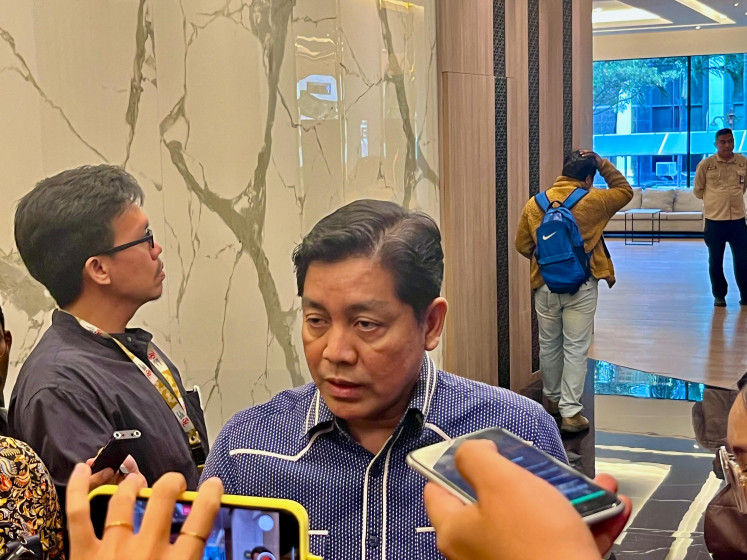Popular Reads
Top Results
Can't find what you're looking for?
View all search resultsPopular Reads
Top Results
Can't find what you're looking for?
View all search resultsASEAN on the verge to becoming regional free-trade bloc: Officials
ASEAN’s path to integrate its respective economies by 2015 is closer to realization as 73
Change text size
Gift Premium Articles
to Anyone
A
SEAN’s path to integrate its respective economies by 2015 is closer to realization as 73.4 percent of its plans under the blueprint of the regional free trade bloc, ASEAN Economic Community (AEC), have been implemented.
Merry meeting: Laotian Trade and Industry Minister Nam Viyaketh (left) greets Deputy US Trade Representative (USTR) Demetrios Marantis (center) in between sessions at the ASEAN Economic Ministers meeting in Manado, North Sulawesi, on Thursday. Antara/Yusran Uccang
“ASEAN has implemented 73.4 percent of the measures under the ASEAN Economic Community blueprint as of the end of July 2011,” the Trade Ministry’s Director of ASEAN Cooperation, Iman Pambagyo, said on the second day of the 43rd ASEAN Economic Ministers (AEM) Meeting in Manado, North Sulawesi, on Thursday.
“We are optimistic the 10 member states can be integrated in one way or another,” Iman said.
Asked if the goal was too optimistic, he recalled the same situation in 1992, when people doubted an ASEAN Free Trade Area (AFTA). “When we started the CPT AFTA in 1992, no-one believed that we could make it. We continued ... and here we are.”
One indication of the success of the ASEAN process to integrate its economies, is the attention from other regional groupings, such as the Gulf Cooperation Council (GCC) and Latin America’s Mercosur. The two, along with other countries, like Pakistan and Turkey, have offered to open dialogue and negotiations to establish free trade areas with ASEAN.
One of the important achievements is in tariff reductions. By 2010, for example, 99.11 percent of tariffs of ASEAN-6 (Brunei, Indonesia, Malaysia, the Philippines, Singapore and Thailand) were already eliminated, while 98.86 percent tariffs of ASEAN-4 (Cambodia, Lao, Myanmar and Vietnam) were ranging between 0 and 5 percent.
Iman also noted the significance of small and medium enterprises (SME) as an important part of the vision to create an inclusive and equitable ASEAN. More than 96 percent of business units in ASEAN are SMEs. SMEs account for 99 percent of business units in Indonesia, Singapore and Thailand.
Based on data from ASEAN’s Secretariat data, SMEs generate between 50 percent and 95 percent of employment, make up 30 percent to 53 percent of the total GDP, and 19 to 31 percent of total exports in ASEAN.
“SMEs play such an important role in ASEAN, including Indonesia. SMEs have also been proven to be resilient and dynamic. In order to realize the vision for an inclusive, equitable, sustainable, and resilient ASEAN, we need to engage SMEs and ensure that they benefit from AEC,” Trade Minister Mari Elka Pangestu said.
ASEAN member states range from resource-rich Indonesia to impoverished Laos, and financial center Singapore. The region is home to 600 million people and a combined GDP of US$2 trillion.
The AFTA Council also noted that intra-ASEAN trade reached $519.7 billion in 2010, an increase of 31.2 percent from $376.2 billion in 2009. The implementation of the above measures will contribute to create an integrated and more competitive ASEAN that can be a regional production base for the global economy.
During the AFTA Council meeting, the economic ministers signed off on several action plans as part of the implementation of ASEAN’s Trade in Goods Agreement (ATIGA). These action plans include a schedule for tariff reductions in the context of ATIGA; development of ASEAN Import Licensing Procedure (ILP) Guidelines; and an extension to the waiver for rice and sugar from Indonesia.










